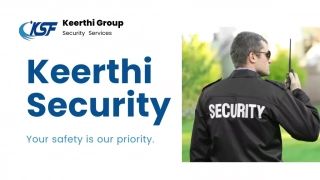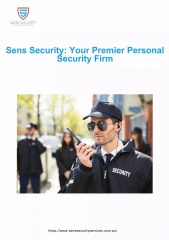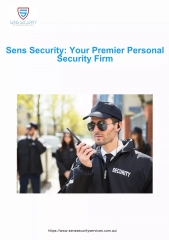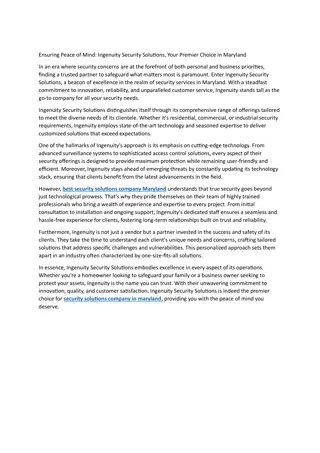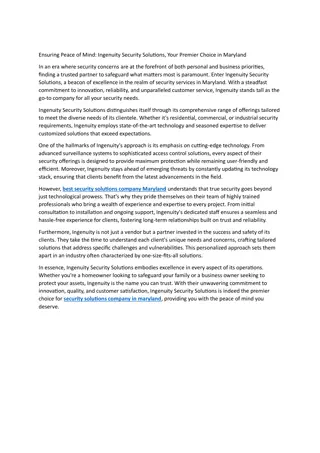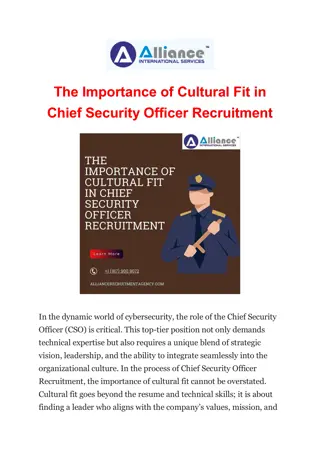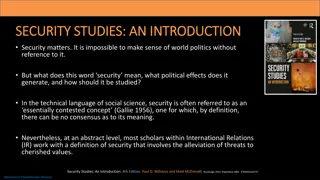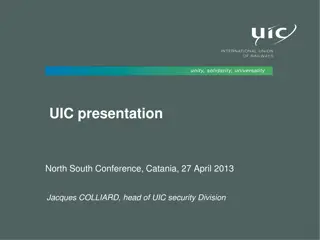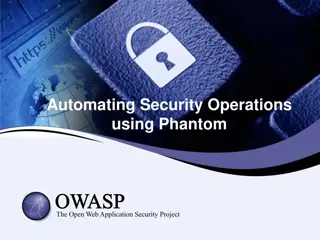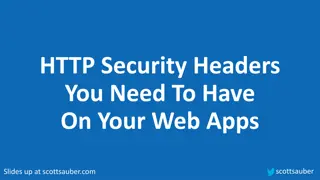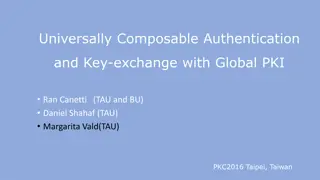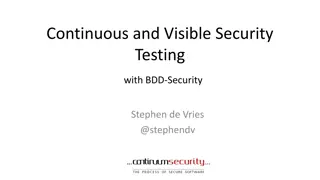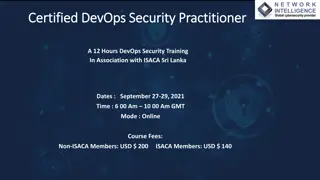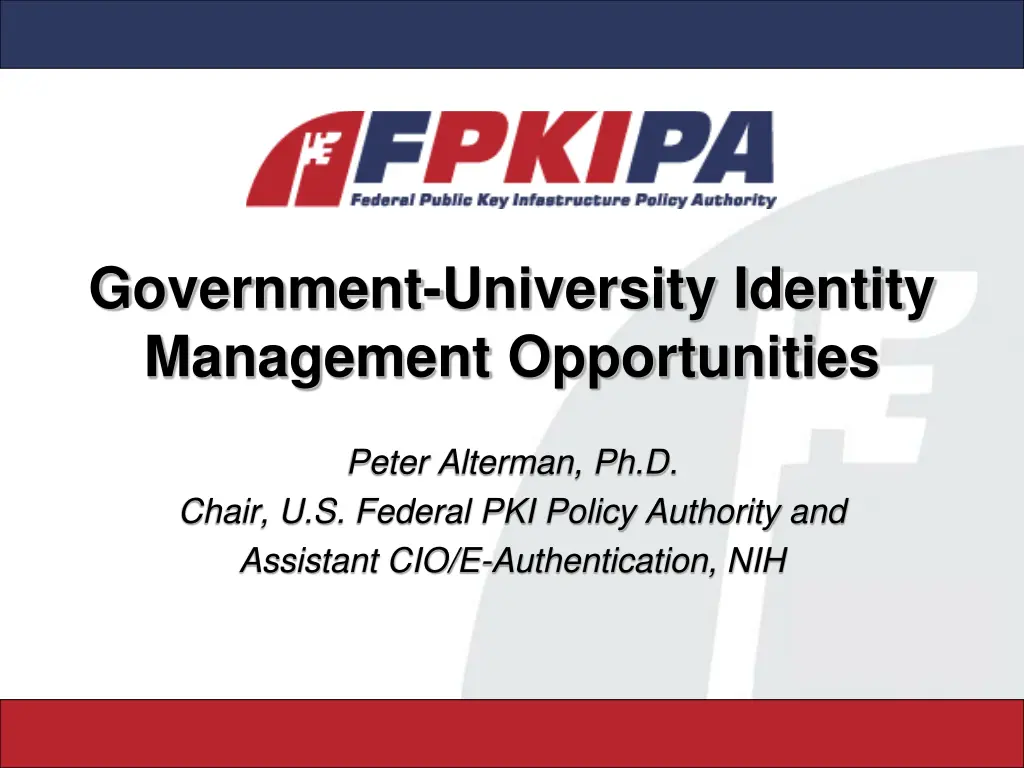
Government University Identity Management Overview
Explore the challenges and solutions in government-university identity management, including e-authentication levels, foundational assumptions, and general considerations. Learn about the importance of electronic identity credentials and the assurance levels required for different online applications.
Uploaded on | 0 Views
Download Presentation

Please find below an Image/Link to download the presentation.
The content on the website is provided AS IS for your information and personal use only. It may not be sold, licensed, or shared on other websites without obtaining consent from the author. If you encounter any issues during the download, it is possible that the publisher has removed the file from their server.
You are allowed to download the files provided on this website for personal or commercial use, subject to the condition that they are used lawfully. All files are the property of their respective owners.
The content on the website is provided AS IS for your information and personal use only. It may not be sold, licensed, or shared on other websites without obtaining consent from the author.
E N D
Presentation Transcript
Government-University Identity Management Opportunities Peter Alterman, Ph.D. Chair, U.S. Federal PKI Policy Authority and Assistant CIO/E-Authentication, NIH
Current State of Affairs (60 years old now) You apply to the application owner for a password You use the password to access the system You forget the password The application owner gives you a new password You use the new password to access the system You forget the password <infinite do loop> No identity proofing No way to know who is actually on the system (Your secretary? Your postdoc? Your dog? Osama?) 2
Foundational Assumption Government online services shall trust externally-issued electronic identity credentials at known levels of assurance (LOA) Online applications shall determine required credential LOA using a standard methodology based on: 1. Risk assessment using standard tool, 2. OMB M-04-04 determines required authN LOA 3. NIST SP 800-63 translates required LOA to credential technology 3
E-Authentication LOA and What They Mean Little or no assurance of identity; assertion-based identity authentication Level 1 Some assurance of identity; assertion-based identity authentication or policy-thin PKI Level 2 Substantial assurance of identity; cryptographically-based identity authentication Level 3 High assurance of identity; cryptographically-based identity authentication Level 4 * Codified in OMB Memorandum 04-04 4
E-Authentication LOA and What They Service** Online applications with little or no risk of harm from fraud, hacking; low risk Level 1 Online applications with risk of some harm from fraud, hacking; some risks Level 2 Online applications where there is risk of significant harm from fraud, hacking; significant risks Level 3 Online applications where there is risk of substantial harm from fraud, hacking; substantial risks Level 4 5 ** Codified in NIST SP 800-63
General Considerations for Determining LOA of an Electronic Identity Credential (EIC) Identity Proofing how sure are you that the person is who he or she claims to be? Identity Binding how sure are you that the person proffering the EIC is the person to whom the credential was issued? Credential integrity how well does the technology and its implementation resist hacking, fraud, etc.? 6
Summary of Lower-Level Identity Credentials Level 1: UserID/Password, SAML assertion (XML text) Level 2: High entropy UserID/Password; policy-lite PKI, e.g., Fed PKI Citizen and Commerce Class & Federal PKI Rudimentary, TAGPMA Classic Plus (in development) 7
Summary of Cryptographic- Based Identity Credentials Level 3:One-time Password; Substantial assurance PKI at FPKI Basic, Medium Level 4:High assurance PKI at FPKI Medium Hardware, High 8
A Little Complication The government has TWO LOA classifications: 1. Federal PKI LOA codified in the Certificate Policies of the Federal PKI Policy Authority 2. E-Authentication LOA codified in OMB M- 04-04 9
LOA Mapping E-Auth to Fed PKI FPKI Rudimentary; C4 E-Auth Level 1 E-Auth Level 2 FPKI Basic FPKI Medium & Medium-cbp E-Auth Level 3 FPKI Medium/HW & Medium/HW-cbp E-Auth Level 4 FPKI High (governments only) 10
How Can A School Credential be Trusted and Used by a Government Application? Preferred path - School joins an Identity Federation that has policy and technology interoperability agreements with E-Authentication Federation Requirements Each Federation agrees to ensure its members operate according to minimum requirements for members of the other s Federation. Presumes substantive policy, technology and management commonality Alternate path 1 School becomes a member Credential Service Provider (CSP) of the E- Authentication Federation directly, signing on to the Federation s technology, business, operating and legal requirements Alternate path 2 One-to-one relationships (sssh!) 11
US Government E-Authentication Interfederation Model 12
E-Authentication Federation Membership Requirements Credential service providers [CSP] submit to credential assessment and evaluation of LOA Both Application providers and CSPs sign on to Federation business and operating standards, legal agreements. 13
E-Authentication InCommon Interfederation Status Candor requires this disclaimer: they re still trying to figure it out after two years and two tries Current status: Said to be getting close with inCommon. Policy-grounded MOA on the table and molding; technical interoperability targeted for SAML 2.0; USPerson profile analog of eduPerson profile in 2.0 version but still pretty much generic. inCommon needs to up its policy, procedures, documentation and audit requirements to play long-term E-Authentication needs to up its privacy protections 14
Fed PKI Cross Certification Process Application - LOA? Policy Mapping Mapping Matrices online Cert Policy WG mapping review Collegial back and forth discussions Technical Interoperability Testing Testing Protocol online Directory and profiles tested (LDAP and/or X.500) Review of summary of independent audit results Map CP > CPS and CPS -> PKI Operations Independent auditors, not FPKI auditors Whole process laid out in Criteria & Methodology document online 16
FPKI Does Interfederate Cross-certified (test) with Higher Education PKI Bridge, 01/2002 Cross-certified (production) with CertiPath Aerospace Industry PKI Bridge at Medium Hardware (EAuth Level 4), 07/2006 Cross-certification under way with SAFE-Biopharma PKI Bridge, Medium and Medium Hardware Processes and procedures spelled out in Criteria and Methodology Document online 17
Current Model for Assertion-Based Interfederation (still a work in progress) For E-Authentication Federation and InCommon to interfederate at LOA 1 (!), E-Auth is requiring InC to: upgrade its policy, audit and management infrastructure to comply with EAuth model, e.g., compliance with Credential Assessment Framework for LOA 1, signing Business and Operating Standards and sign Legal Agreement Satisfy technical interoperability testing using SAML 1.0 technology, though work is proceeding to migrate to SAML 2.0 technology InCommon has designated this state of operation InCommon Bronze Compatibility with E-Authentication requirements for LOA 2 is called InCommon Silver 18
What about Level 3 Government Apps Today? Universities issuing PKI-based electronic credentials may cross-certify with the Federal PKI at Basic Assurance or above Ex. MIT Lincoln Lab, University of Texas System (in process) Usually 3 6 months Or acquire digital certificates from a vendor currently cross-certified with the Federal Bridge at Basic assurance or above Many options 19
Seeded Questions Q: What about the recent DOD notice that PKI individual certs are required for access to their web resources. Will DOD sites ever trust university-issued certificates for access or will we have to shell out $$ to get to them? A: If you think YOU are fussing about this, imagine how furious State Dep t. and NASA are. Imagine how furious their contractors are. A: We (Fed PKI) have been talking to DOD about this issue and we hope to see progress in 2007. Q: What the heck is password entropy? A: See next slide 20
Password Entropy (Copied From Bill Burr)* Entropy is measure of randomness in a password Stated in bits, a password with 24 bits of entropy is as hard to guess as a 24 bit random number The more entropy required in the password, the more trials the system can allow It s easy to calculate the entropy of a system-generated, random password But users can t remember these Much harder to estimate the entropy of user-chosen passwords Composition rules and dictionary rules may increase entropy *NIST KBA Symposium, Feb. 9, 2004 21
Resources www.cio.gov/eauthentication www.cio.gov/fpkipa http://csrc.nist.gov www.cio.gov/ficc 22
Notes 1.) How does your institution issue IDs? Is there a signature station requiring photo ID? What about non-resident scientists from Japan? 2.) What is password entropy? Complex vs. long passwords. How often must they be changed? Can they be re-used? Pass dictionary test? 3.) How secure is the authentication infrastructure? Can one person jeopardize the process? How are ID records stored? 4.) How is the process documented? Are there templates to use as a framework that will pass Federal standards? 23



